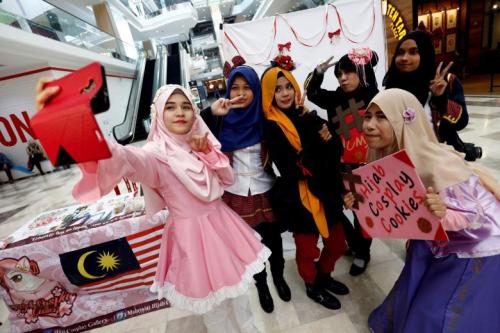Meet the hijabster - young, hip Muslim women in S-E Asia

Meet the hijabster - young, hip Muslim women in S-E Asia
Echoing Nancy Smith-Hefner's 2007 study of higher rates of veiling in Indonesia, this article from the Straits Times details how young women are simultaneously both more Muslim and more cosmopolitan. The article, which quotes from a study by J Walter Thompson Intelligence, illustrates how increased veiling and attention to Islamic practices has continued well into the 2010s and is not just a trend confined to Indonesia, but has appeared in neighbouring Malaysia, as well.
One added dimension in this article that was not so pronounced in Smith-Hefner's work is the theme of cosmopolitanism. The "New-Muslimah" are a globally oriented group of people: one third of survey respondents travel overseas at least once a year; Malaysian artists are making headway into audiences around the world (such as Yuna in the US and Shila Amzah in China); and entrepreneurs are exporting their products (ranging from tech to fashion) elsewhere. All this while demonstrating more religiosity, too, with 95% of respondents saying religion is important to them while more and more women choose to adopt the hijab. The study thus highlights the compatibility between more intense religious belief and "modernity." While Smith-Hefner places the hijab in the domestic context of the Indonesian university while scrutinizing relationship dynamics between women and men, this article focuses on how this new generation of young women, affectionately dubbed the "hijabsters," enterprisingly look outward.
The article also makes numerous mentions of fashion and hints at how the hijab has become adapted into numerous styles with women creating their own lines and selling/showing them over the internet (this Youtuber even has some Hijab "how-to's" - https://www.youtube.com/user/TheMizzeira/videos). For those who cry foul against a seemingly more "oppressed" section of the populace, these fashion trends indicate how the hijab can be a conduit through which young women can project their agency and creative force.
The Youtuber linked above, Zakirah Zainal, says, "I also feel there is a lot of support from society for young Muslim women to venture into business and e-Commerce." I wonder about the extent to which this applies to the hijab fashion industry. We saw in Smith-Hefner a little bit of inertia towards the purported objectification of the hijab - how stylizing it sort of defeats the purpose of looking more chaste. Perhaps attitudes have changed (or may be different in Malaysia than in Indonesia). From her quote, Zainal certainly does not feel much disdain from society, so perhaps sentiments may have warmed these past few years. Another perspective to look at is the flip side of the coin - some interviewed in the Smith-Hefner reading worry about the danger of pressure to conform to this new norm. It would be intriguing to examine how attitudes of/towards non-hijabis have changed, if at all.